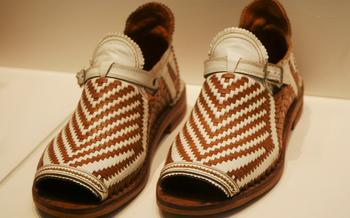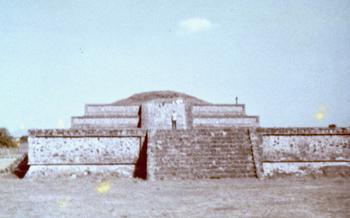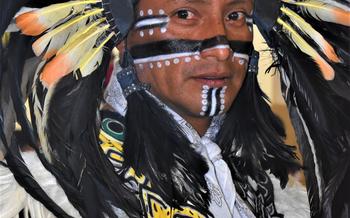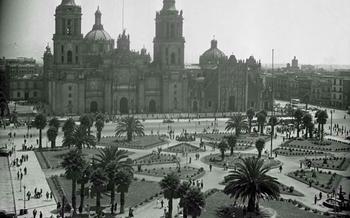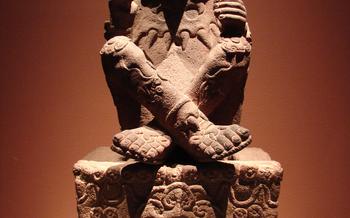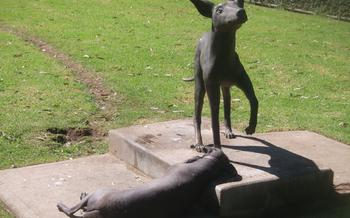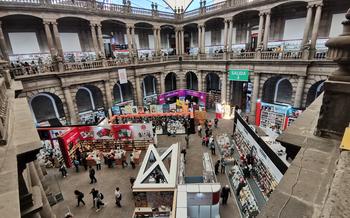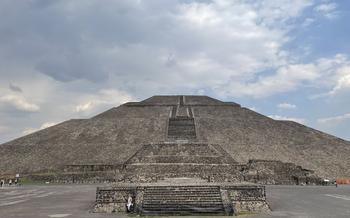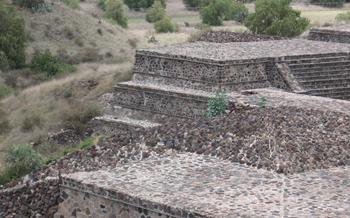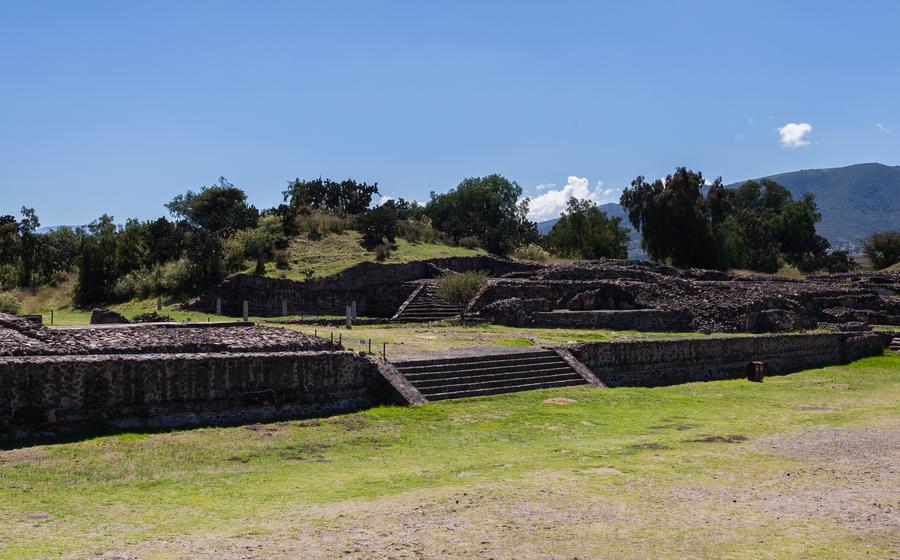
Museo de Arte Popular
- The Museo de Arte Popular in Teotihuacan: A Journey into Mexican Folk Art
- Unveiling the Treasures of Mexican Craftsmanship
- A Vibrant Showcase of Mexican Traditions
- Exploring the Museum's Collections
- Immerse Yourself in Interactive Experiences
- A Walk Through the Museum's Galleries
- Meet the Artisans Behind the Masterpieces
- Delve into the Symbolism and Meanings
- Engage with the Dynamic Art Scene
- Plan Your Visit to the Museo de Arte Popular
- Capture the Beauty of Mexican Folk Art
- Souvenirs and Mementos from the Museum Shop
- Insider Tip: Uncover Hidden Gems in the Museum
The Museo de Arte Popular in Teotihuacan: A Journey into Mexican Folk Art
Nestled in the heart of Teotihuacan, the Museo de Arte Popular stands as a testament to the rich cultural heritage of Mexico. Founded in 1975, this museum is dedicated to showcasing the remarkable artistry and craftsmanship of Mexican folk art. Situated within walking distance from the iconic Pyramids of the Sun and Moon, the museum offers a unique opportunity to immerse yourself in the vibrant traditions and diverse expressions of Mexican culture.
With its striking architectural design, featuring a series of interconnected courtyards and galleries, the Museo de Arte Popular creates a captivating setting for its extensive collection of folk art. The museum's collection boasts over 6,000 pieces, representing the diverse regions of Mexico and showcasing the exceptional skills and creativity of Mexican artisans. From intricate pottery and colorful textiles to whimsical alebrijes and hand-carved wooden figures, the museum offers a comprehensive exploration of Mexico's rich artistic traditions.
Unveiling the Treasures of Mexican Craftsmanship
The Museo de Arte Popular in Teotihuacan houses an impressive collection of Mexican folk art, showcasing the diverse range of traditional crafts and techniques practiced throughout the country. Visitors can marvel at intricate pottery from Oaxaca, colorful woven textiles from Chiapas, and delicate silver jewelry from Taxco. The museum's collection highlights the skills and creativity of Mexican artisans, who use a variety of materials, including clay, wood, metal, textiles, and natural fibers, to create unique and beautiful objects.
The artwork on display reflects the rich cultural influences that have shaped Mexico's artistic traditions. Pre-Columbian motifs and symbols are interwoven with elements of Spanish colonial art, creating a unique fusion that is characteristic of Mexican folk art. The pieces often depict scenes from everyday life, capturing the essence of Mexican culture and traditions. They also carry deep symbolic meanings, reflecting the beliefs and values of the communities that created them.
A Vibrant Showcase of Mexican Traditions
The Museo de Arte Popular in Teotihuacan is not just a repository of artifacts; it is a vibrant tapestry that weaves together the diverse threads of Mexican cultural heritage. Each piece of folk art is a testament to the rich traditions and customs that have been passed down through generations.
The museum's collection showcases the regional variations in Mexican folk art, highlighting the unique artistic expressions of different states and communities. Visitors can trace the evolution of traditional motifs and techniques as they traveled from one region to another, adapting and evolving along the way.
The connection between Mexican folk art and indigenous cultures is deeply rooted. Many of the designs, symbols, and techniques used by artisans today can be traced back to pre-Columbian civilizations. The museum pays homage to this rich heritage by showcasing pieces that draw inspiration from ancient traditions, ensuring that these cultural roots remain alive.
Moreover, the museum plays a crucial role in preserving these traditions by providing a platform for artisans to showcase and sell their work. By supporting local artisans, the museum not only helps to sustain traditional livelihoods but also ensures that these skills and knowledge are passed down to future generations.
Exploring the Museum's Collections
The Museo de Arte Popular houses a vast and diverse collection of Mexican folk art, showcasing the rich cultural heritage and artistic traditions of the country. The permanent collection features an impressive array of pieces from various regions of Mexico, representing different techniques, materials, and styles. Visitors can admire intricate textiles, vibrant ceramics, finely crafted metalwork, colorful glassware, and an array of other traditional crafts.
Temporary exhibitions and special displays are organized regularly to highlight specific themes, showcase the work of renowned artisans, or delve into the history and evolution of Mexican folk art. These temporary exhibitions often feature interactive elements, multimedia presentations, and educational programs that enhance the visitor experience.
The museum also offers educational programs and workshops that provide visitors with hands-on opportunities to learn about traditional Mexican crafts. These workshops, led by experienced artisans, allow participants to try their hand at various techniques, such as pottery, weaving, or embroidery, and create their own unique pieces of folk art.
The curatorial approach of the Museo de Arte Popular emphasizes the importance of storytelling and cultural context. Each piece in the collection is carefully selected and displayed to tell a story about the artist, the region it comes from, and the cultural traditions it represents. Through well-researched labels, interactive displays, and guided tours, the museum invites visitors to engage with the artwork on a deeper level and gain a profound appreciation for the cultural significance of Mexican folk art.
Immerse Yourself in Interactive Experiences
The Museo de Arte Popular in Teotihuacan offers visitors a range of interactive experiences that bring Mexican folk art to life. Engage in hands-on activities and workshops led by skilled artisans, where you can learn traditional techniques and create your own unique pieces. Immerse yourself in multimedia presentations and audiovisual exhibits that showcase the vibrant colors and intricate details of the artwork. Interactive displays invite visitors to engage with the art, providing insights into the symbolism and stories behind each piece. Through these interactive experiences, the museum fosters a deeper appreciation for Mexican folk art and its cultural significance.
A Walk Through the Museum's Galleries
The Museo de Arte Popular in Teotihuacan is a treasure trove of Mexican folk art, with its galleries showcasing a diverse array of traditional crafts and contemporary interpretations. Visitors are taken on a journey through the vibrant world of Mexican artistry, with each gallery offering unique insights into the country's rich cultural heritage.
The museum's layout is designed to provide a comprehensive overview of Mexican folk art, with galleries dedicated to specific regions, techniques, and themes. Each gallery is curated with care, presenting a selection of representative pieces that highlight the distinctive characteristics of the region or style.
Must-see highlights include the intricate wood carvings of Oaxaca, the colorful textiles of Chiapas, the whimsical alebrijes of Mexico City, and the delicate pottery of Puebla. The museum also features temporary exhibitions and special displays that showcase the work of emerging artists or explore specific themes in Mexican folk art.
To fully appreciate the museum's collection, visitors are encouraged to explore at their own pace and take advantage of the informative labels and audio guides that provide insights into the history, techniques, and symbolism of the artwork. Guided tours are also available for a more in-depth understanding of the museum's highlights.
The Museo de Arte Popular is not just a repository of artifacts; it is a vibrant space that invites visitors to engage with Mexican folk art on a deeper level. By exploring its galleries, visitors can gain a profound appreciation for the skill, creativity, and cultural significance of this remarkable art form.
Meet the Artisans Behind the Masterpieces
The Museo de Arte Popular in Teotihuacan not only showcases stunning artifacts but also provides visitors with the opportunity to meet the talented artisans who bring these creations to life. These artisans are the heart and soul of Mexican folk art, and their dedication and skill are evident in every piece on display.
Meet Doña María, a master weaver from Oaxaca, whose intricate tapestries tell stories of her ancestors. Her nimble fingers create vibrant patterns and textures, transforming threads into mesmerizing works of art.
Discover the magic of Don Pedro, a renowned potter from Jalisco, whose hands mold clay into elegant and whimsical forms. His pottery is not just functional but also a canvas for his creativity, adorned with intricate designs and vibrant colors.
Learn from Señora Juana, a skilled jeweler from Chiapas, who transforms silver and gemstones into exquisite jewelry. Her pieces are inspired by nature and tradition, each one a unique masterpiece.
Through interactive demonstrations and workshops, visitors can witness the artisans at work, gaining a deeper appreciation for the time, effort, and artistry that goes into each piece. These encounters offer a glimpse into the creative process and the passion that drives these talented individuals.
By meeting the artisans and understanding their stories, visitors can connect with the cultural heritage and traditions that shape Mexican folk art. These encounters transform the museum experience into a celebration of creativity, skill, and the human spirit.
Delve into the Symbolism and Meanings
Beyond their captivating aesthetics, the artworks at the Museo de Arte Popular hold profound symbolic meanings, deeply rooted in Mexican mythology, folklore, and cultural traditions. Each piece carries a narrative, often inspired by ancient legends, deities, or everyday life experiences. These symbols and stories offer a glimpse into the rich cultural heritage of Mexico and provide a deeper understanding of the country's identity.
For instance, the intricate designs on a ceramic plate might depict scenes from the Popol Vuh, the sacred book of the Maya people, narrating the creation of the world and the adventures of the hero twins. A colorful alebrije, a fantastical creature made of papier-mâché, might embody a nahual, a spirit animal believed to protect and guide individuals. The vibrant colors and patterns of a woven textile could convey messages of love, fertility, or protection, drawing on indigenous beliefs and traditions.
Exploring the symbolism and meanings behind the artwork at the Museo de Arte Popular is a fascinating journey that invites visitors to connect with the heart and soul of Mexican culture. It's an opportunity to appreciate the art not just for its beauty but also for its ability to communicate stories, beliefs, and emotions that have been passed down through generations.
Engage with the Dynamic Art Scene
The Museo de Arte Popular is not just a static repository of artifacts; it is a vibrant hub of cultural exchange and artistic expression. Throughout the year, the museum hosts a diverse range of events, festivals, and workshops that celebrate Mexican folk art and provide visitors with opportunities to engage with the dynamic art scene. These events offer a unique chance to witness live demonstrations by skilled artisans, participate in hands-on workshops, and immerse yourself in the rich traditions of Mexican craftsmanship.
One of the highlights of the museum's calendar is the annual Feria de las Manos (Fair of the Hands), a week-long festival that showcases the work of over 200 artisans from across Mexico. This vibrant event features live music, dance performances, traditional food stalls, and the opportunity to purchase unique handmade crafts directly from the artisans themselves.
The museum also offers a variety of educational programs and workshops throughout the year. These programs are designed to provide visitors with a deeper understanding of Mexican folk art, its history, and its cultural significance. Participants can learn traditional crafting techniques, create their own artwork, and gain insights into the creative processes of the artisans.
By engaging with the dynamic art scene at the Museo de Arte Popular, visitors can not only admire the exquisite craftsmanship of Mexican folk art but also connect with the artisans who keep these traditions alive. These events and programs provide a unique opportunity to immerse oneself in the vibrant cultural heritage of Mexico and to appreciate the artistry and creativity of its people.
Plan Your Visit to the Museo de Arte Popular
Visiting the Museo de Arte Popular in Teotihuacan is an enriching experience that offers insights into Mexican culture and heritage. To make the most of your visit, it's essential to plan ahead.
Essential Visitor Information:
- Hours of Operation:
Capture the Beauty of Mexican Folk Art
The Museo de Arte Popular encourages visitors to capture the beauty of the artwork through photography, allowing them to document and share their experiences. However, certain guidelines must be followed to ensure the preservation of the art and the privacy of other visitors.
Photography is permitted in most areas of the museum, but the use of flash and tripods is prohibited. This helps to minimize disturbances and protect the delicate artifacts from damage. Visitors are encouraged to turn off their camera's flash to avoid causing glare or distracting other visitors.
When capturing the essence of the artwork, it's essential to maintain a respectful distance and avoid touching or leaning against the pieces. The museum's staff is always willing to assist visitors with any questions or concerns they may have.
For those who wish to share their experiences on social media, the museum encourages the use of hashtags such as #MuseoDeArtePopular, #MexicanFolkArt, and #Teotihuacan. By sharing their photos and stories, visitors can help to promote the museum and raise awareness of the incredible artistry of Mexican folk art.
The museum's gift shop offers a variety of unique and authentic Mexican crafts that can serve as lasting mementos of your visit. Proceeds from the shop support local artisans and contribute to the museum's mission of preserving and promoting Mexican folk art.
Remember to pack your camera and capture the vibrant colors, intricate details, and profound stories of the artwork. Your photographs will not only serve as beautiful reminders of your time at the Museo de Arte Popular but also contribute to the preservation and appreciation of Mexican folk art.
Souvenirs and Mementos from the Museum Shop
As you exit the captivating galleries of the Museo de Arte Popular, don't miss the opportunity to visit the museum shop, a treasure trove of authentic Mexican crafts. Here, you can find a diverse selection of souvenirs and mementos to commemorate your visit and support local artisans.
The museum shop is meticulously curated, ensuring that each item is of the highest quality and represents the diverse regional traditions of Mexican folk art. From intricate pottery and hand-woven textiles to colorful papier-mâché figures and whimsical alebrijes, there's something for every taste and budget.
By purchasing a souvenir from the museum shop, you directly contribute to the livelihoods of talented artisans and support the museum's mission to preserve and promote Mexican folk art. Every purchase helps sustain the cultural heritage of Mexico and empowers artisans to continue creating their exquisite masterpieces.
When selecting your souvenirs, take your time to appreciate the intricate details and craftsmanship of each piece. Consider the stories and traditions behind the artwork, and choose items that resonate with you on a personal level. Whether it's a vibrant embroidered blouse, a hand-painted ceramic plate, or a whimsical wooden carving, your souvenir will serve as a lasting reminder of your journey into the heart of Mexican folk art.
For international visitors, the museum shop offers secure packaging and shipping options, ensuring that your precious souvenirs reach their destination safely. You can also find a variety of postcards, books, and other publications that delve deeper into the history and significance of Mexican folk art.
So, as you bid farewell to the Museo de Arte Popular, don't forget to visit the museum shop and take a piece of Mexico's vibrant cultural heritage home with you. Your purchase will not only bring you joy but also contribute to the preservation and continuation of this remarkable tradition.
Insider Tip: Uncover Hidden Gems in the Museum
Beyond the main galleries, the Museo de Arte Popular holds hidden treasures waiting to be discovered. Venture off the beaten path to uncover secret spots and lesser-known exhibits that offer a more intimate and enriching experience. One such gem is the "Taller de Artesanía", a workshop where visitors can observe skilled artisans demonstrating traditional techniques and creating intricate pieces of folk art.
For a peaceful and crowd-free visit, plan your trip during weekdays or early mornings. This allows you to fully immerse yourself in the museum's ambiance and appreciate the artwork without distractions. Take advantage of this serene atmosphere to engage in deep contemplation and reflection on the cultural significance and symbolism embedded within each piece.
To further enhance your experience, consider joining a guided tour. Knowledgeable guides can lead you through the museum's hidden corners, sharing captivating stories and insights about the artwork and its creators. These tours offer a deeper understanding of the museum's collection and the cultural heritage it represents.
As you explore the museum, keep an eye out for interactive displays and multimedia presentations that bring the artwork to life. These immersive experiences allow you to engage with the pieces on a deeper level, gaining a newfound appreciation for the skill and artistry of Mexican craftsmen.
Finally, remember to take advantage of the museum shop, where you can find a treasure trove of unique and authentic Mexican crafts. Proceeds from your purchases directly support local artisans and help sustain the museum's mission of preserving and promoting Mexican folk art.
